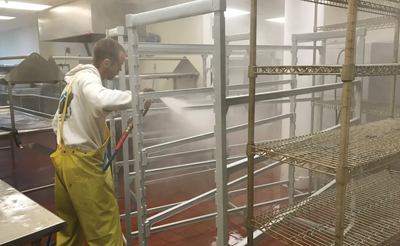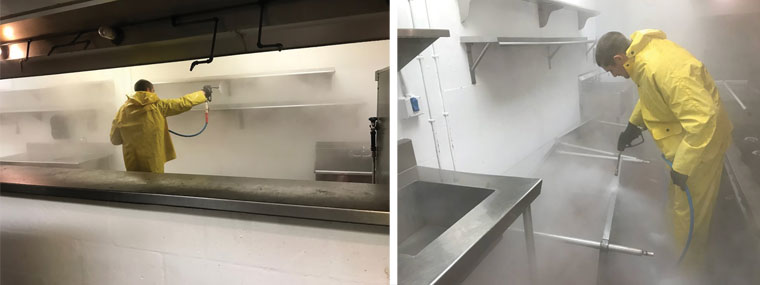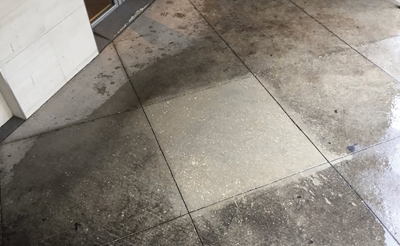
Food for Thought—Cleaning Restaurants
By Diane M. Calabrese / Published November 2023

Expectations are the focus of restaurateurs. Shouldn’t their focus be on the food? Well, yes, but patrons who enter a restaurant usually want much more than something to eat.
A clean, comfortable, and safe experience are all among the expectations of diners. There’s always takeout, delivery, and microwaveable grocery items for those who just want a break from cooking.
Members of our industry (or supply contractors) who clean restaurants know the significant role they fill. By doing an excellent job, they ensure customers have an excellent experience.
Power washing contractors may not often deploy a pressure washer, but they do plenty of work to keep restaurants—including their environs—clean.
“Most restaurant surface cleaning is done without a pressure washer, but the major exception is hood cleaning,” says Joseph Daniel, CEO of ITD Inc. in Tucker, GA. “Hood cleaning is a large service industry that requires heavy-duty, high-quality chemical products as well as pressure washer use.”
With the certification and thorough training required for hood cleaning—think of the grease and fire potential—some contractors stay away from restaurant cleaning. In some regions where the demand for such contractors is high, that could be a business mistake.
Certification requirements are just part of the entry path. Each state has criteria food establishments must meet, and it sends out inspectors periodically to ensure criteria are met. (Find a portal to individual state rules by visiting FDA.gov. The U.S. Food and Drug Administration has significant purview over cleanliness of restaurants.)
“Regulatory compliance is certainly a major hurdle among the challenges of cleaning restaurants,” says Daniel. “The chemical products used on or around contact surface areas must be compliant,” he notes.
In other words, outcomes are being monitored by regulators. But input—chemicals used—are being monitored too.
Some challenges are not unique to restaurants; among them is scheduling. It will never do to have a full cleaning team overlap with those eating a meal.
“The heavy-duty cleaning work is often completed in the middle of the night,” says Daniel. Of course, that means a contractor must have team members willing to work at night, which adds another challenge.
Then there’s the need for prudence in the choice of chemicals. Efficacy and environmental considerations must be matched. “Chemical selection is more complex than just what works best,” says Daniel. “The responsible contractor ensures he is using high-quality chemicals that are in compliance with the restaurant industry.”
It’s correct that better ventilation systems, stainless-steel food preparation surfaces, and strong-but-tempered disinfectants have made restaurants easier to keep clean over time. There are fewer nooks and crannies for mold to grow and debris and grease to accumulate.
On the other hand, some culinary changes add health risks to a restaurant. Among them are uncooked foods (from raw fish to salad bars), undercooked food (very rare beef), and so on. There are many complexities.
Yet just as there is a lid for every pot, there are members of the power washing industry who are deeply present in the restaurant cleaning niche, and in the next two sections two of them share some of their experience to give us the flavor of it all.
MONEY MATTERS
If it were ever a truism that customers are willing to pay for quality, it’s not in 2023. Some are, but not all.
“Sanitary conditions are paramount for restaurants, as well as aesthetics,” says John Cloud, president of Gorilla Kleen in Sarasota, FL. “We have only one restaurant, though, that hires us each year to literally go through everything.”
Everything means just that. “They remove the food, utensils, etc.,” says Cloud. “We flip over stainless carts, clean stainless shelving, and pull stoves out from the wall and clean up grease that is deposited there.”
As for the how, it’s two team members using mostly spray nozzles, not guns, says Cloud. Each operator deploys a 200°F hot water machine. Yes, it gets steamy, and operators must compensate for visibility issues (e.g., fogging up of protective eye wear.)
“We clean out the insides of the freezers and refrigerated storeroom—everything on that job,” explains Cloud. He adds, “But remember, I said only one venue hires for such a thorough cleaning.”
Cloud notes that there’s frugality among restaurant owners that can work against optimal outcomes. “We occasionally get a restaurant that is willing to spend money,” he remarks.
But inexplicable things do happen. “We had a burger affiliate that we cleaned the outdoor dining area for every two weeks,” says Cloud. “The guys would hit it very early in the morning and kept it immaculate; it cost about $325 each visit. The chain closed that location, which is odd, since it is located in a thriving area,” he comments.
The most difficult restaurant venues to clean are those that are almost always open. Cloud’s team tackles venues including coffee and donut shops that only close four hours a day. Assigning a team to clean just four hours in the middle of the night isn’t practical.
“I finally figured out that I could contract the four-hour job out to one of my guys, because it can be a one-man job,” says Cloud. “He cleans the loading dock and dumpster area of a large restaurant, then the two coffee places, in the middle of the night on a weekend and in less than four hours,” he adds.
 Balancing what a restaurant owner will agree to pay for with the work to be done can be a big challenge. In the interest of cost cutting, some owners ignore areas that should be cleaned.
Balancing what a restaurant owner will agree to pay for with the work to be done can be a big challenge. In the interest of cost cutting, some owners ignore areas that should be cleaned.
“Grease trails out the front door make a restaurant look horrible; you would think that they would care more, but typically they don’t,” says Cloud. “And then, there is the problem of them taking their rubber mats out the back door into the alley and washing them there, leaving the asphalt in the alley a greasy mess,” he continues.
Cloud’s company gets involved downstream. “The city pays us to clean the alleyways, but the restaurants are driving that business for us,” he explains. “The city also has us under contract to clean all the sidewalks in key areas of town—some monthly, but all at least two times per year—[and] grease trails again tend to drive the need, that and gum.”
Contractors sometimes must decline work. Usually it’s because they cannot charge enough—i.e., the owner will not pay more. One large chain wanted work done only on Sunday, every Sunday, and named a cap on payment that was not workable for his company, says Cloud.
An owner-operator might have been able to make the numbers work, explains Cloud, but he encourages careful assessment, including factoring in the work is every Sunday.
Contract work often comes via contracts attained through bids, explains Cloud. He says that getting the award may mean doing demonstrations, such as the one he recently did on cleanup of grease trails. (He got a five-year renewal.)
Cloud says the “really good” degreaser he used in the demonstration provided a big assist. Using the best ancillaries and equipment is the bottom line.
WIDE SCOPE
Are you ready to enter the sphere of restaurant cleaning? Consider a few more recommendations derived from experience.
“Pressure washers and steam cleaners can be useful tools in cleaning restaurants, both for exterior and interior cleaning tasks,” says Jud West, owner of WashRite Services in Valdosta, GA. “Pressure washers can be especially helpful for cleaning exterior surfaces such as sidewalks, entrance areas, dumpster pads, and drive-throughs.”
It’s a matter of whether a contractor is trying to remove dirt (pressure washer) or more (steam). The “more” includes not only grease but entities such as “stubborn stains” and gum, explains West.
In addition to using steam for kitchen exhaust and grease buildup, there’s another place where it gives a big boost to outcomes. “Steam cleaners can be useful for cleaning floors in dining rooms and restrooms, as they use high-temperature steam without the use of chemicals,” says West.
“A safe restaurant environment is the goal,” notes West, “both inside and outside.”
That safety encompasses the absence of grease and oil that may increase fire risk or cause trips and falls. Naturally, it also includes the assurance to customers that bacteria and viruses are not lurking on surfaces.
“Cleaning a restaurant can be a challenging task,” says West. Among the many factors that must be considered, grease ranks high.
Even a thin veneer or small patch of grease accumulated on surfaces makes them slippery and hard to clean. “Removing grease requires specialized chemicals and tools and can be a time-consuming task,” says West.
Weigh all the challenges when deciding whether to offer restaurant cleaning services. To the scheduling around customers, add being attuned to the wants of management regarding best times, says West.
An owner may have security and other concerns that a contractor must respect. “Finally, meeting regulations is essential to ensure that the restaurant is safe and clean for customers,” adds West.
Regulations for food safety, cleanliness, and sanitation must be followed scrupulously, explains West. Many federal entities enter the picture. Safety involving foodborne disease draws regulators and their input from OSHA, CDC, the USDA, and the FDA.
To review a simplified consolidation of relevant federal regulation, see “Foodborne Disease,” an OSHA document via www.osha.gov/foodborne-disease/control-prevention. But again, the state level (health department) is the place to start.
Also put EPA in the regulator mix. Wastewater from cleaning must be properly handled.
According to the CDC, most of the yearly 800 food-borne disease outbreaks begin in restaurants. CDC reports that in places where health departments require restaurants to post inspection results, there are fewer outbreaks. Perhaps a spurious correlation, but monitoring may motivate cleanliness.
“Deep cleaning should be done on a regular basis, typically every few months or as needed,” says West. All surfaces, inside and outside and the underside of appliances and storage areas, get dirty.
“It is important to use cleaning products that are safe when deployed in a food-service environment and that are effective at removing dirt, grime, and bacteria,” comments West. “Be sure to follow the manufacturer’s instructions for use and dilution rates. Different stains require different chemicals.”
First, do no harm. A chemical used incorrectly can result in residue or volatile compounds that cause health problems for restaurant staff or customers.
Even contractors that may not be interested in working inside can find work in the restaurant sector by attending to exteriors, including windows, walls, parking lots, and sidewalks, explains West. Any service a contractor can offer a restaurateur that ensures the expectations of customers are met is a service that can be sold.







